Greek Deca Durabolin Yellowtop
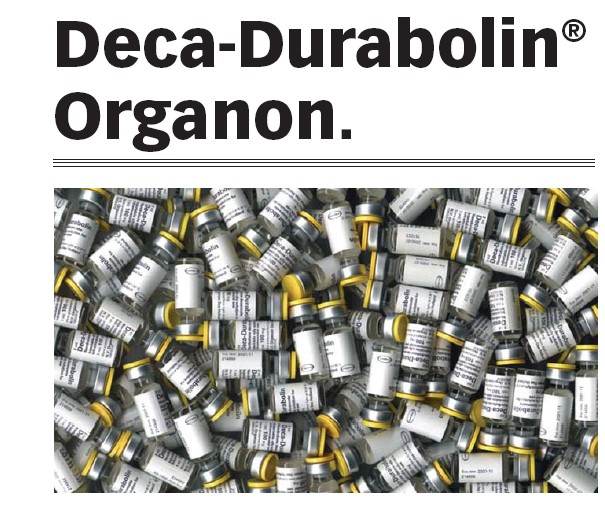 BY RONNY TOBER 2006
BY RONNY TOBER 2006
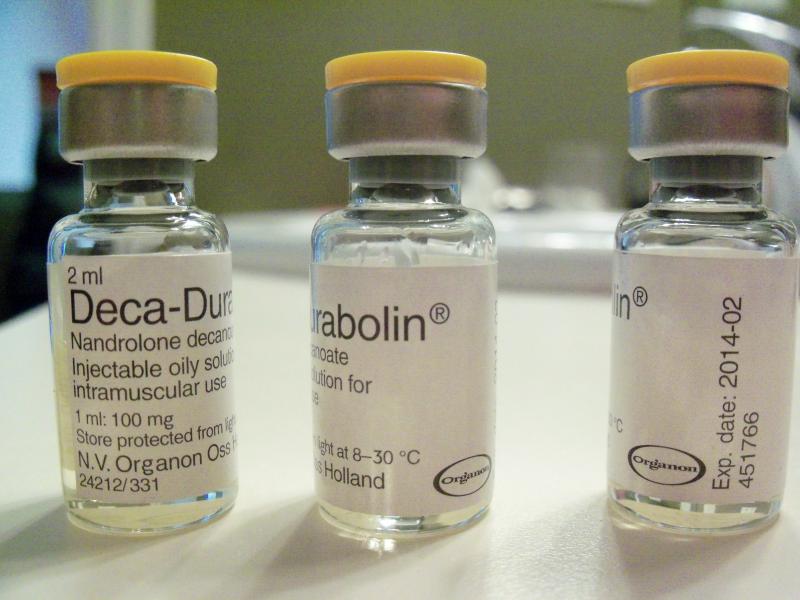 I wrote this article in 2006 for a great bodybuilding magazine. Times changed and a year after this article was posted Organon Greece produced its last vials. Does that mean they disappeared from the market? The real ones did, but the counterfeits are still readily available (see picture). I’ll post more from my old articles and will update them as soon as they change appearance.
I wrote this article in 2006 for a great bodybuilding magazine. Times changed and a year after this article was posted Organon Greece produced its last vials. Does that mean they disappeared from the market? The real ones did, but the counterfeits are still readily available (see picture). I’ll post more from my old articles and will update them as soon as they change appearance.
Organon, a business unit from Akzo Nobel Holland, introduced Deca-Durabolin (nandrolone decanoate) during the early 1960’s. They made it available in strengths of 25, 50, and 100 mg/ml. The brand name Deca-Durabolin® is often abbreviated as “Deca”, an abbreviation that has become synonymous with the active agent Nandrolone Decanoate.Due to its favorable high anabolic and low androgenic qualities, Deca- Durabolin soon became the most widespread and commonly used injectable anabolic steroid in the world. In bodybuilding circles, the characteristic 2-milliliter vials with the yellow flip top became the backbone of many stacks.
This article concerns “Yellow Top”Organon Deca-Durabolin from Greece, or more specifically how to detect and avoid counterfeits of this popular drug. Many Europeans like to celebrate their vacations along the sunny coasts of Southern Europe. To the surprise of many bodybuilders, steroids are more freely available over the counter their, especially in Greece, where clever suppliers stockpile enormous amounts to cash in on steroid tourism. In Spain, the maximum strength of Deca is 50 mg/ml. But in Greece, where many older people use this drug medically to improve their quality of life, there are higher-dosed brands like Norma Hellas®, Extraboline®, and of course Deca-Durabolin®. All of these Greek Deca products can be found to contain 100 mg/ml of steroid,and come in 2 milliliter vials. Extraboline® and Norma® are “generic”medications, and have long had a reputation for being underdosed.Later laboratory analyses confirmed this suspicion, at least the limited number we’ve seen. Still, such drugs are very popular. On the other hand, Dutch made Deca-Durabolin from Organon had gained an almost mythical reputation of quality that lasts until today. The demand for this brand, especially for the Greek market produced Organon “Yellow Top”, exceeds the supply greatly. When people want the best Greek Deca, this is the one they buy.These yellow tops are a humangrade European brand-name medicine, and they are expensive. Given its high cost and demand, counterfeits hit the market as soon as the crooks took notice. In the beginning, the counterfeits were rather primitive. But later, when bodybuilding magazines and the World Wide Web started to spread knowledge, the fakes started to look almost identical to the real thing. That’s exactly why picture forums, such as www.juicedmuscle.com , are so tremendously popular. The community stays informed, and counterfeiters are forced to make betterlooking fakes if they want to stay in business. Since the year 2000,Organon has changed the look of the Yellow Tops thoroughly. But even today, the oldest (counterfeited) styles are still being sold.That’s why we want to discuss the older styles and counterfeits as well as the new ones in this article. As you will see, history has a way of repeating itself. Let’s get into the counterfeits, shall we? This is a picture from a legitimate Organon box manufactured in 1996 (Fig.1). 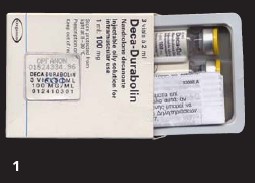 Later, in 1999,Organon added to the box in red lettering the text, “Under medical prescription filed by pharmacy for two years.” This text reminds of a regulation in Greece, requiring the pharmacist to remove the pharmacy sticker from a drug box (this sticker is present on all Greek prescription drugs) and affix it to the patient’s card. The pharmacist is to draw a stripe through the sticker with a marker if he sells the drug to a customer that does not have patient paperwork, like tourists. Now we have a compilation picture with a number of different counterfeits of the old packaging (Fig.2).The legitimate products they are copied from are long gone, but not all bodybuilders, especially the non-Europeans, know this .On the left is the only real vial. There are a number of points that give away the counterfeits.
Later, in 1999,Organon added to the box in red lettering the text, “Under medical prescription filed by pharmacy for two years.” This text reminds of a regulation in Greece, requiring the pharmacist to remove the pharmacy sticker from a drug box (this sticker is present on all Greek prescription drugs) and affix it to the patient’s card. The pharmacist is to draw a stripe through the sticker with a marker if he sells the drug to a customer that does not have patient paperwork, like tourists. Now we have a compilation picture with a number of different counterfeits of the old packaging (Fig.2).The legitimate products they are copied from are long gone, but not all bodybuilders, especially the non-Europeans, know this .On the left is the only real vial. There are a number of points that give away the counterfeits. 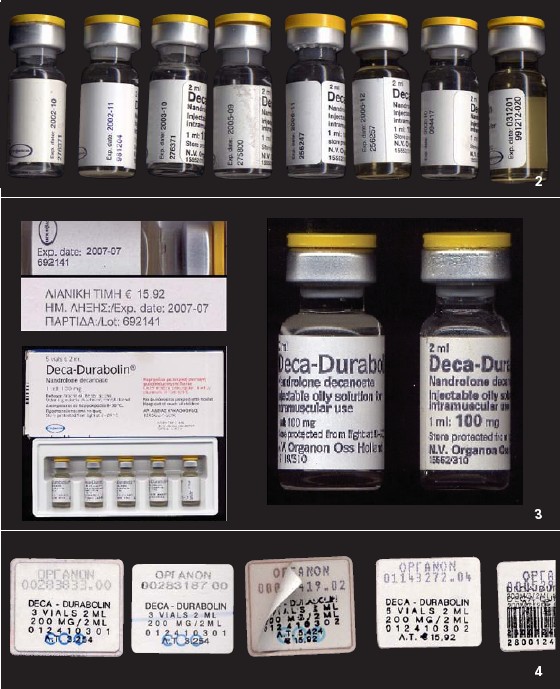 To begin with, some of the labels are not glued completely around the vial in an overlapping manner like the original. Others have rounded edges, instead of the correct squared ones of the original. Also, even in these old small vials Organon used a specific septum (the rubber trough which the user has to stick the needle).The color together and specific shape of their septum is hard for counterfeiters to find, and thus they often use substitutes. Most are very easy to spot in the picture when you have the real one to compare it to. Also, pay special attention to the crimping of the aluminum crimp cap. One of the vials stands out immediately for its poor/cheap crimping. We’ll see more on that later in this article. Now we get to the new/current from of Greek Organon Deca (Fig.3).We see in this comparison photo the new thicker vial from the 5-pack, as it sits next to the thinner old vial from the 3-pack box, pictured on the right. When the new version first came out, everybody assumed that it had to be a fake, because the vial was so much thicker than the old one. The label had changed just as well, such like the product number. Organon always worked with a label that overlapped in the past as well, yet this new one only partly covered the vial. I remember that I sent the first shipment of new Deca back to Greece, because I did not know that the appearance had changed myself. I thought for sure these oblong boxes of five vials were illegitimate, and that my supplier tried to con me. I am glad I was wrong. As you can see, the expiration date and lot number are both printed on both box and vial, and the box comes with a leaflet. On the other side of the box you will find the pharmacy sticker we mentioned before. When someone becomes aware of the fact that they purchased a counterfeited vial, the most commonly asked question next is, what does it contain? During a time period of three years (00-03) 11 Yellow Top vials were analysed through the anti-doping agency in Holland. They found the real one containing 99.6 mg/ml Nandrolone Decanoate, right on the mark. They found 6 counterfeits that contained 18.6 mg/ml, 19.1 mg/ml,7.0 mg/ml,21.5 mg/ml,18.9 mg/ml and 18.2 mg/ml Nandrolone Decanoate, far below what it should. They found 1 fake, which contained nothing but pure oil. From another counterfeited batch they examined three samples to see if the contents in one batch were uniform, well, they where not. The three vials contained 60 mg/ml – 67 mg/ml – 82 mg/ml. Which means these counterfeits, aside from lacking the high content of genuine working pharmaceutical ingredients, were clearly not produced in a real pharmaceutical lab. There was just no consistency. If the three would have been alike, they could have been manufactured by a real chemical company but sold as underdosed counterfeits. This is today quite common. It is a known fact that certain pharmaceutical companies in China will produce blank amps and vials for their customers, and leave it for them to decide how to label its contents and doses. In fact, these vials do contain real nandrolone decanoate, which is not common for other counterfeits. Take Primobolan, for example,which is often counterfeited with a bit of nandrolone decanoate, which misguides the user into thinking they purchased real Primobolan. At least in these cases the buyer was usually getting real Deca, though not in the required (labelled) dosage. The pictured pharmacy stickers are showed here in comparison with a fake (second from the left)(Fig.4).The left one is a real one from the production year 2000.On the sticker the year of production is made visible in the last two numbers behind the period. You can clearly see that the fake sticker is glued directly on the box, while the real stickers are all attached on a kind of waxed backing paper which allows the pharmacist easy removal and affixation. The third sticker from the left was produced in the year 2002 (.02). Today, many bodybuilders today are aware of the existence of a watermark hidden inside of Greek pharmacy stickers. This trait brings the counterfeiters much more trouble. I flatter myself with the thought that I was the first to reveal the existence of a watermark inside Greek stickers when I posted pictures rately duplicated the real stickers, finally?
To begin with, some of the labels are not glued completely around the vial in an overlapping manner like the original. Others have rounded edges, instead of the correct squared ones of the original. Also, even in these old small vials Organon used a specific septum (the rubber trough which the user has to stick the needle).The color together and specific shape of their septum is hard for counterfeiters to find, and thus they often use substitutes. Most are very easy to spot in the picture when you have the real one to compare it to. Also, pay special attention to the crimping of the aluminum crimp cap. One of the vials stands out immediately for its poor/cheap crimping. We’ll see more on that later in this article. Now we get to the new/current from of Greek Organon Deca (Fig.3).We see in this comparison photo the new thicker vial from the 5-pack, as it sits next to the thinner old vial from the 3-pack box, pictured on the right. When the new version first came out, everybody assumed that it had to be a fake, because the vial was so much thicker than the old one. The label had changed just as well, such like the product number. Organon always worked with a label that overlapped in the past as well, yet this new one only partly covered the vial. I remember that I sent the first shipment of new Deca back to Greece, because I did not know that the appearance had changed myself. I thought for sure these oblong boxes of five vials were illegitimate, and that my supplier tried to con me. I am glad I was wrong. As you can see, the expiration date and lot number are both printed on both box and vial, and the box comes with a leaflet. On the other side of the box you will find the pharmacy sticker we mentioned before. When someone becomes aware of the fact that they purchased a counterfeited vial, the most commonly asked question next is, what does it contain? During a time period of three years (00-03) 11 Yellow Top vials were analysed through the anti-doping agency in Holland. They found the real one containing 99.6 mg/ml Nandrolone Decanoate, right on the mark. They found 6 counterfeits that contained 18.6 mg/ml, 19.1 mg/ml,7.0 mg/ml,21.5 mg/ml,18.9 mg/ml and 18.2 mg/ml Nandrolone Decanoate, far below what it should. They found 1 fake, which contained nothing but pure oil. From another counterfeited batch they examined three samples to see if the contents in one batch were uniform, well, they where not. The three vials contained 60 mg/ml – 67 mg/ml – 82 mg/ml. Which means these counterfeits, aside from lacking the high content of genuine working pharmaceutical ingredients, were clearly not produced in a real pharmaceutical lab. There was just no consistency. If the three would have been alike, they could have been manufactured by a real chemical company but sold as underdosed counterfeits. This is today quite common. It is a known fact that certain pharmaceutical companies in China will produce blank amps and vials for their customers, and leave it for them to decide how to label its contents and doses. In fact, these vials do contain real nandrolone decanoate, which is not common for other counterfeits. Take Primobolan, for example,which is often counterfeited with a bit of nandrolone decanoate, which misguides the user into thinking they purchased real Primobolan. At least in these cases the buyer was usually getting real Deca, though not in the required (labelled) dosage. The pictured pharmacy stickers are showed here in comparison with a fake (second from the left)(Fig.4).The left one is a real one from the production year 2000.On the sticker the year of production is made visible in the last two numbers behind the period. You can clearly see that the fake sticker is glued directly on the box, while the real stickers are all attached on a kind of waxed backing paper which allows the pharmacist easy removal and affixation. The third sticker from the left was produced in the year 2002 (.02). Today, many bodybuilders today are aware of the existence of a watermark hidden inside of Greek pharmacy stickers. This trait brings the counterfeiters much more trouble. I flatter myself with the thought that I was the first to reveal the existence of a watermark inside Greek stickers when I posted pictures rately duplicated the real stickers, finally? 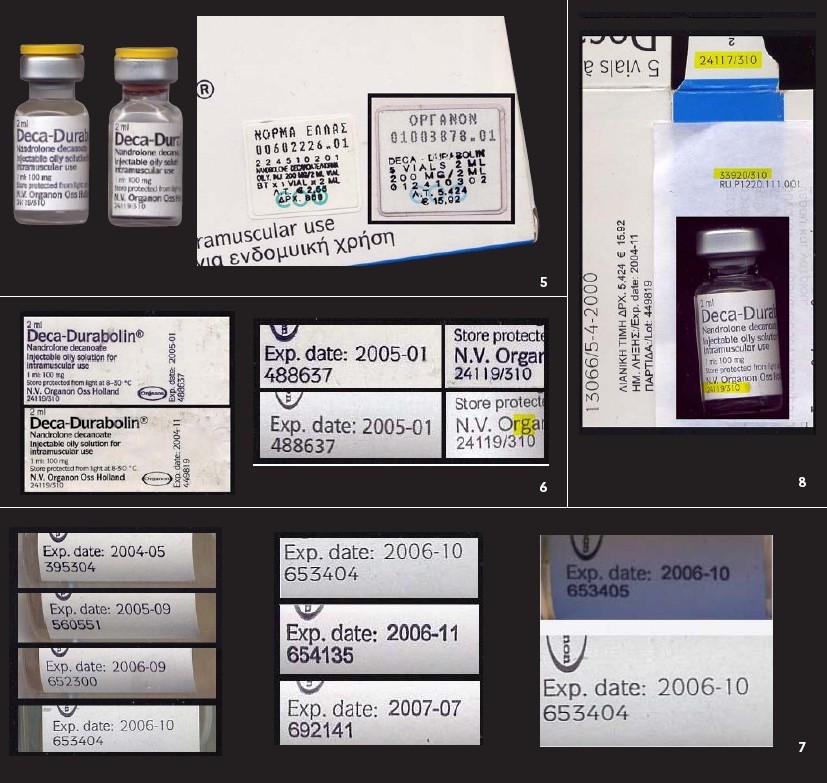 When I took a closer look, I discovered that the inventive counterfeiter had simply glued on a sticker taken from a Norma Hellas box. Looking at the price, one would wish it were true. It is a simple trick, really. Buy some Norma, sell it but keep the stickers, and reuse them to push bogus 5 vial boxes of expensive Organon Deca. In the black frame you see the sticker that really should have been on the box, were it real. If there is one thing aside from the pharmacy sticker that has really helped separate the real product from the counterfeits, it was the letter-type used for the lot number and expiration date (Fig. 6). Organon formerly used a very specific compressed font on their product, which had an open “4” and a “3” with a flat top. On the comparison picture the difference is very visible. On top is the real label, and underneath a counterfeit. The lop-sided “g” highlights another deviation noticeable in this counterfeit. It definitely is not of the correct font. Here is a series of lot numbers and expiration dates that shows a more recent switch (Fig. 7). They begin using the older compressed letter-type,which ran until lot number 653404. This was the last date Organon Yellow Top Deca was made with this lettertype. The lot number 653405 and forward were made in a new letter-type.As you can see, this new font is much more common, and has already be used in other counterfeits. This unfortunate change of printing deprives us of a very helpful tool in determining the legitimacy of obtained vials. Remarkably, however, the old letter-type is still found used with the ID number,which sits underneath “N.V.Organon”. Organon Greek Deca also bears an ID number for internal use (Fig.8).Every packaging item gets its own unique number for quality control purposes, and allows Organon to identify and avoid errors during the packaging process. The ID number ends with a slash and three more digits, in this case 310,which is used for nandrolone decanoate. The old vials had different ID numbers, but after the slash the 310 remained the same. The same is true for the 50 mg/ml 1 ml ampoule. The leaflet and box do, of course, have different ID numbers, as they are different items of packaging material. On this picture we take another closer look at two vials. The real one sits on the right, giving us an easy vantage point for comparison with counterfeit on the left. With the guidance of a few pictures, I want to make clear how important a good closing is and how difficult it is for the counterfeiter to crimp their vials exactly like the pharmaceutical company. A company like Organon has very expensive equipment, while the counterfeiter often uses a hand crimper (a kind of big pincer). If another pharmaceutical firm makes the counterfeit, they are still likely to use a different crimping machine. In this picture you can see the cap on the counterfeit (left) has been closed under with a 90° angle. Organon crimps its top with a less pronounced angle. This allows them to precisely fit the top to and close vial completely, protecting the contents from its surroundings, which can contaminate the content with germs etc. A properly closed vial is important to maintain sterility. On this picture it is also visible that Organon uses aspecific light grey septum. The fake has a shorter one, but more about this later. Also, take a good look on the color of the oil. Organon always uses the same clear oil, where the counterfeits often use oil that is a bit yellowish in colour, as seen here. The part of the label that is visible also shows that the counterfeiter was not aware of the fact that Organon uses a very specific letter “D” in the word Deca-Durabolin.
When I took a closer look, I discovered that the inventive counterfeiter had simply glued on a sticker taken from a Norma Hellas box. Looking at the price, one would wish it were true. It is a simple trick, really. Buy some Norma, sell it but keep the stickers, and reuse them to push bogus 5 vial boxes of expensive Organon Deca. In the black frame you see the sticker that really should have been on the box, were it real. If there is one thing aside from the pharmacy sticker that has really helped separate the real product from the counterfeits, it was the letter-type used for the lot number and expiration date (Fig. 6). Organon formerly used a very specific compressed font on their product, which had an open “4” and a “3” with a flat top. On the comparison picture the difference is very visible. On top is the real label, and underneath a counterfeit. The lop-sided “g” highlights another deviation noticeable in this counterfeit. It definitely is not of the correct font. Here is a series of lot numbers and expiration dates that shows a more recent switch (Fig. 7). They begin using the older compressed letter-type,which ran until lot number 653404. This was the last date Organon Yellow Top Deca was made with this lettertype. The lot number 653405 and forward were made in a new letter-type.As you can see, this new font is much more common, and has already be used in other counterfeits. This unfortunate change of printing deprives us of a very helpful tool in determining the legitimacy of obtained vials. Remarkably, however, the old letter-type is still found used with the ID number,which sits underneath “N.V.Organon”. Organon Greek Deca also bears an ID number for internal use (Fig.8).Every packaging item gets its own unique number for quality control purposes, and allows Organon to identify and avoid errors during the packaging process. The ID number ends with a slash and three more digits, in this case 310,which is used for nandrolone decanoate. The old vials had different ID numbers, but after the slash the 310 remained the same. The same is true for the 50 mg/ml 1 ml ampoule. The leaflet and box do, of course, have different ID numbers, as they are different items of packaging material. On this picture we take another closer look at two vials. The real one sits on the right, giving us an easy vantage point for comparison with counterfeit on the left. With the guidance of a few pictures, I want to make clear how important a good closing is and how difficult it is for the counterfeiter to crimp their vials exactly like the pharmaceutical company. A company like Organon has very expensive equipment, while the counterfeiter often uses a hand crimper (a kind of big pincer). If another pharmaceutical firm makes the counterfeit, they are still likely to use a different crimping machine. In this picture you can see the cap on the counterfeit (left) has been closed under with a 90° angle. Organon crimps its top with a less pronounced angle. This allows them to precisely fit the top to and close vial completely, protecting the contents from its surroundings, which can contaminate the content with germs etc. A properly closed vial is important to maintain sterility. On this picture it is also visible that Organon uses aspecific light grey septum. The fake has a shorter one, but more about this later. Also, take a good look on the color of the oil. Organon always uses the same clear oil, where the counterfeits often use oil that is a bit yellowish in colour, as seen here. The part of the label that is visible also shows that the counterfeiter was not aware of the fact that Organon uses a very specific letter “D” in the word Deca-Durabolin. 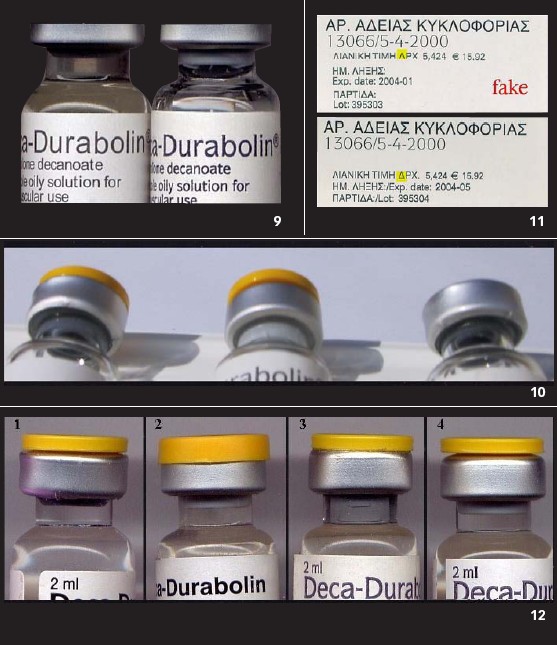 The fake just doesn’t match the real thing. (Fig. 9) On this additional picture (Fig. 10) we see the downside of the aluminium cap. In the middle is the real one, which serves as our standard of comparison. On the left you see a badly crimped cap that can be moved around the vial by hand. The cap on the far right is also open on one side, and visibly
The fake just doesn’t match the real thing. (Fig. 9) On this additional picture (Fig. 10) we see the downside of the aluminium cap. In the middle is the real one, which serves as our standard of comparison. On the left you see a badly crimped cap that can be moved around the vial by hand. The cap on the far right is also open on one side, and visibly
wrinkled and shrunken. Both of the counterfeits have deviant colour septums of the wrong length. On this picture we see two parts of the box (Fig. 11).The layout of the fake is deviant
from the real one, and it was an indication to examine the box and vials more thoroughly. If you look at the lot number and expiration date on both boxes, you see that in the four months separating these two boxes, only these two batches could have been produced (lot number 395303 vs. 395304). This is pure nonsense, of course. The actual lot number that should belongs to this expiration date/manufacturing date is ~ 395025, not 395303. These boxes should have been made during the transition period when there were two currencies available in Greece, the Drachma and the Euro. Both these counterfeits are easy to recognise because the “G” in the word Organon is leaning backwards and is off-line with the other letters. At the highlight you’ll see that the counterfeiter made a clerical fault in the Greek text. This shows again the fact that the more items are counterfeited, such as boxes, leaflet, trays, and vials, the bigger the chance is that somewhere a fault will be made. It’s not only the labels (vaguely visible on this comparison picture) that separate the fakes from real (Fig. 12).We also see deviations in the way the yellow fliptop is tightened on the aluminium cap. We should also take a close look at the septum (the rubber through which the injection needle is being stuck to fill the syringe). # 4 is a real vial and is used here as a standard for the rest to be compared to. Sometimes the counterfeits use a septum of a different color, be it dark grey, black, or red. These are always fake. But on this picture we have three counterfeited vials with septa of the same color as the real one. Let’s look further. # 1 has rounded corner labels with black lettering in the wrong letter-type. The yellow fliptop is also attached to the aluminium cap very tightly,with no space to place your fingernails underneath the top. The crimping is also bad, the cap is incorrectly angled and affixed to the vial, and the septum is too small. # 2 also has black lettering in the wrong letter-type, and it doesn’t have a yellow flip top cap. Instead, it has a yellow cap just like Extraboline®, which covers the top instead of rests above it. Also, the “neck” of the vial is too long. # 3 has a good-looking printing in the right letter-type and color and even the typical “D” in Deca-Durabolin is made with the correct font. But the flip-off top is tightened too closely, and the metal cap is slightly rounded on the top. But it is the very long septum, which goes through the entire neck, which is a dead giveaway to me. 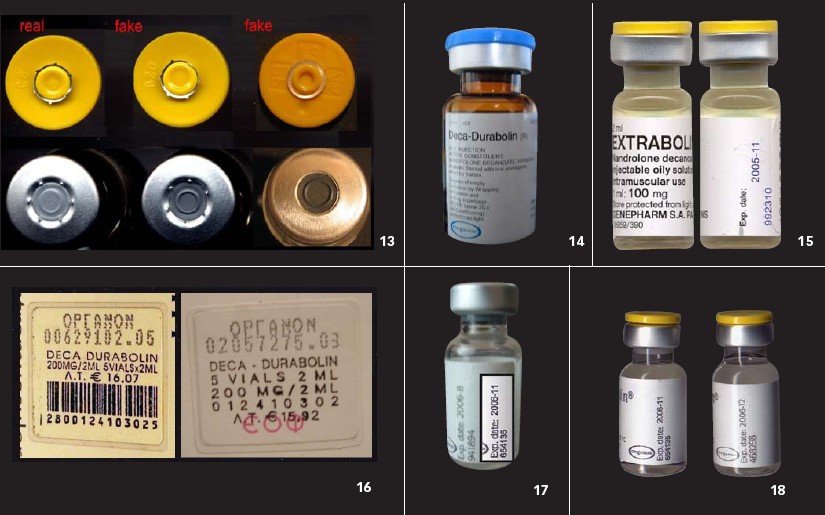 Also, look at the inside of the flip off cap, as well as the inside ring of metal that it is bound to (Fig. 13).Notice the real picture on the left. Although close in appearance, there are clear deviations of both of the counterfeits shown here.
Also, look at the inside of the flip off cap, as well as the inside ring of metal that it is bound to (Fig. 13).Notice the real picture on the left. Although close in appearance, there are clear deviations of both of the counterfeits shown here.
I mentioned at the beginning of this article that Organon is a branch of Akzo Nobel, which manufactures human grade pharmaceuticals. Akzo Nobel also has a branch that manufactures veterinary pharmaceuticals. This branch is called Intervet. That fact makes this amber vial with the blue cap an immediate fake (Fig 14).Human European Deca does not come in such “unsanitary” multi-dose vials. Had Akzo Nobel wanted to make veterinary nandrolone (and they do), it would be produced by Intervet, not Organon. Greek Extraboline vials are similar looking to those of Yellow Top Deca (Fig. 15). Materials that are used to make counterfeit Organon Deca are probably used by some operations to product knockoffs of Greek Extraboline as well (and vice versa). Real Extraboline has a yellow cap instead of a flip top, and sometimes, as we discussed, counterfeit Yellow Top Deca-Durabolin comes with a full cap ala Extraboline instead of a proper flip top. This counterfeiter also incorrectly made their product similar to Organon, by the placement of an ID number on the vial label. Original Extraboline doesn’thave an internal ID number like Organon. Besides that, real Extraboline doesn’t have a label that overlaps like Organon’s. Also, the expiration date and lot number are printed on the label just like Organon does, which deviates from real Extraboline. The same deviant purple printing can found on some counterfeited vials of Organon Deca- Durabolin too. Note that in September 2005 the tax on all Greek medicines went up 1%.This meant a price increase for the yellow tops. The price went up from 15,92 euro for five 2-millilitre vials, to 16,07 euro.Before we go any further, I should remind you to make sure that your product reflects this change (Fig. 16). At the end of 2005 I received some new counterfeits that I won’t deny you.A few are so clumsy that we can identify them as fakes on the first sight. The first has a label with rounded corners, and bears a lot number (941894 expiring in 2006-8)(Fig. 17). According to the production numbers, that lot should not expire until the year 2012. No way. You can see the production number of a real vial expiring 3 months later in comparison, in the insert box. Another one from the same year looks rather good, but again, bears the wrong data (Fig. 18). It expires in December 2006,but it bears a lot number (468298), which was from the year 2002. These counterfeiters also forgot that the letter-types on this data changed. They are still using the font with the open 4. A little too late guy. Another remarkable counterfeit is lot number 654700, expiring 2007-08.But that lot number actually belongs to another month. This is another one in a row of fakes with non-existing and non-matching lot/expiration data. These counterfeits have very good-looking labels; I will give them that. But the position of the text on the label differs with almost every label. The same is true for the position of the label on the vial. Organon glues the labels on the vials with automatic machinery. Placed in a box they will be precisely the same height. On these counterfeit vials, the labels are even slanted. Not a sign of automated machinery. Another remarkable fact is that the metal top on the vials is crooked, and all of the tops are damaged. This is probably because the counterfeiters used a crimping tool that was not designed for these specific flip top caps. The labels of these vials are also very easy to remove; kind of like a cheap sticker. The labels of the real Organon Deca-Durabolin won’t come off that easily. They are also attached to the vial so tight that you’d have to cut them loose with a razor blade. Otherwise, it is impossible to remove the real label in one piece.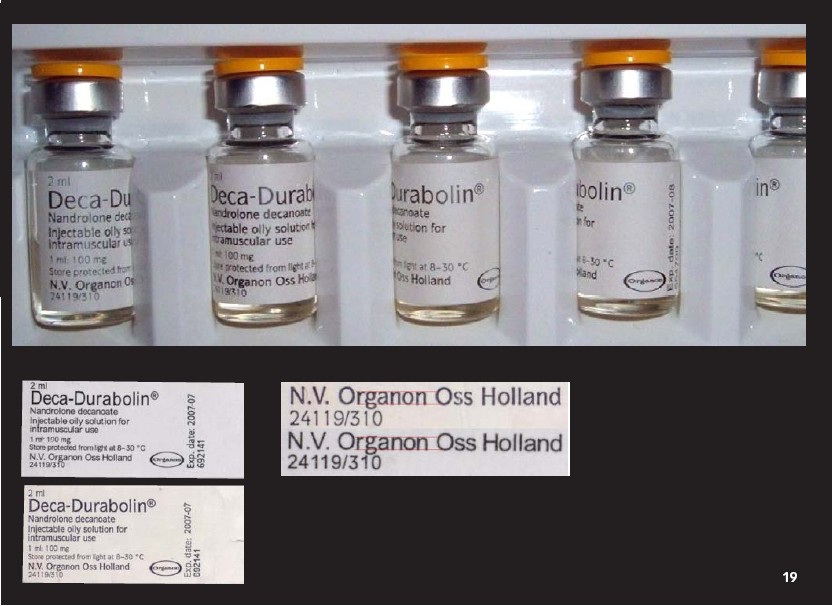 This last counterfeit we show here is almost perfect. I tried a few times to obtain a vial for this article, but unfortunately only have the labels to show you. It is an improved version of another older counterfeit (488637 exp date: 2005-01) (Fig. 19). Both these counterfeits are easy to recognise because the “G” in the word Organon is leaning backwards and is off-line with the other letters. This counterfeiter has excellent looking data on the labels, in the correct letter-types. He also has used, just like with his older counterfeit, existing and matching lot numbers and expiration dates. He has enough common sense to realise that once users are aware of non-existing or non-matching data; this will ruin sales for them. He also knew and used the new letter-types that Organon uses on its new labels. Only one thing, he forgot that Organon used these new lettertypes ONLY on the data. The rest of the label stayed the same. The closed 4 under “N.V. speaks for itself.
This last counterfeit we show here is almost perfect. I tried a few times to obtain a vial for this article, but unfortunately only have the labels to show you. It is an improved version of another older counterfeit (488637 exp date: 2005-01) (Fig. 19). Both these counterfeits are easy to recognise because the “G” in the word Organon is leaning backwards and is off-line with the other letters. This counterfeiter has excellent looking data on the labels, in the correct letter-types. He also has used, just like with his older counterfeit, existing and matching lot numbers and expiration dates. He has enough common sense to realise that once users are aware of non-existing or non-matching data; this will ruin sales for them. He also knew and used the new letter-types that Organon uses on its new labels. Only one thing, he forgot that Organon used these new lettertypes ONLY on the data. The rest of the label stayed the same. The closed 4 under “N.V. speaks for itself.  Upon analysis, this counterfeit was show to contain a small dose of testosterone propionate.This is unusual, because most counterfeits seem to contain a small amount of nandrolone.
Upon analysis, this counterfeit was show to contain a small dose of testosterone propionate.This is unusual, because most counterfeits seem to contain a small amount of nandrolone.
Until next Time – RT.
- Login to post comments


